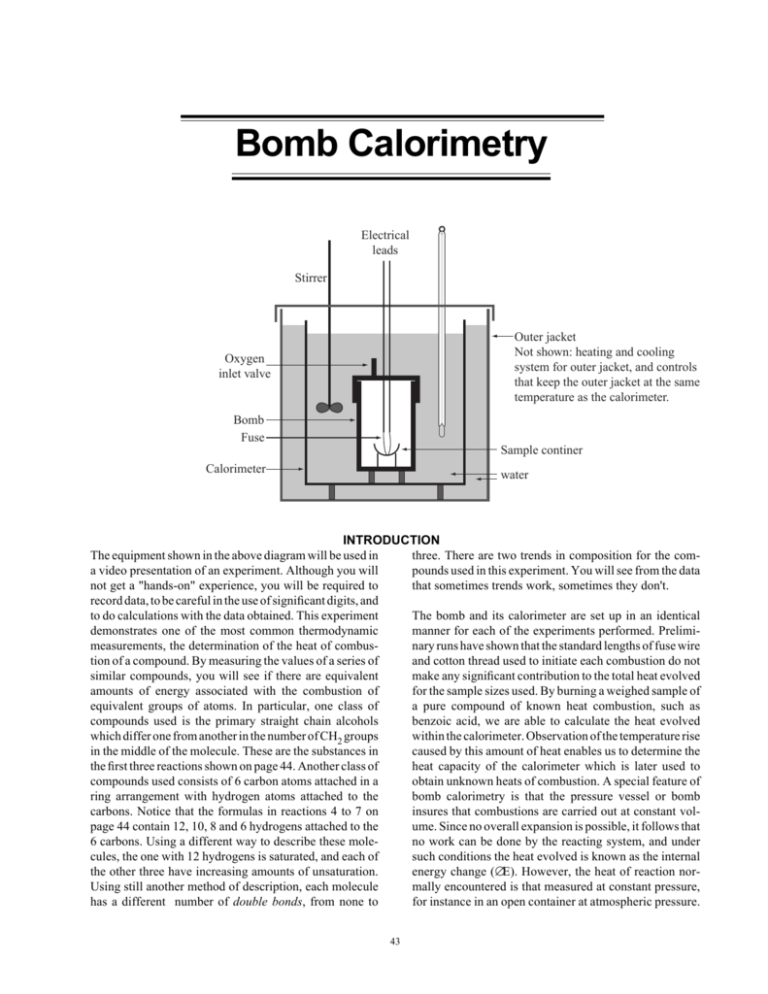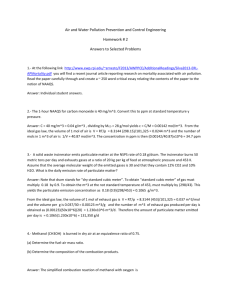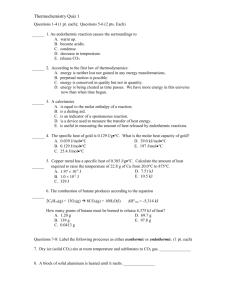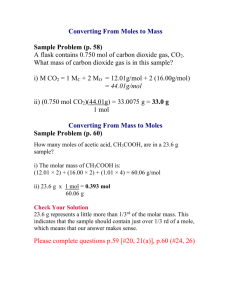Bomb calorimeter
advertisement

Bomb Calorimetry Electrical leads Stirrer Outer jacket Not shown: heating and cooling system for outer jacket, and controls that keep the outer jacket at the same temperature as the calorimeter. Oxygen inlet valve Bomb Fuse Sample continer Calorimeter water INTRODUCTION three. There are two trends in composition for the comThe equipment shown in the above diagram will be used in pounds used in this experiment. You will see from the data a video presentation of an experiment. Although you will that sometimes trends work, sometimes they don't. not get a "hands-on" experience, you will be required to record data, to be careful in the use of significant digits, and The bomb and its calorimeter are set up in an identical to do calculations with the data obtained. This experiment manner for each of the experiments performed. Prelimidemonstrates one of the most common thermodynamic measurements, the determination of the heat of combusnary runs have shown that the standard lengths of fuse wire tion of a compound. By measuring the values of a series of and cotton thread used to initiate each combustion do not similar compounds, you will see if there are equivalent make any significant contribution to the total heat evolved amounts of energy associated with the combustion of for the sample sizes used. By burning a weighed sample of equivalent groups of atoms. In particular, one class of a pure compound of known heat combustion, such as compounds used is the primary straight chain alcohols benzoic acid, we are able to calculate the heat evolved which differ one from another in the number of CH2 groups within the calorimeter. Observation of the temperature rise in the middle of the molecule. These are the substances in caused by this amount of heat enables us to determine the the first three reactions shown on page 44. Another class of heat capacity of the calorimeter which is later used to compounds used consists of 6 carbon atoms attached in a obtain unknown heats of combustion. A special feature of ring arrangement with hydrogen atoms attached to the bomb calorimetry is that the pressure vessel or bomb carbons. Notice that the formulas in reactions 4 to 7 on insures that combustions are carried out at constant volpage 44 contain 12, 10, 8 and 6 hydrogens attached to the ume. Since no overall expansion is possible, it follows that 6 carbons. Using a different way to describe these moleno work can be done by the reacting system, and under cules, the one with 12 hydrogens is saturated, and each of such conditions the heat evolved is known as the internal the other three have increasing amounts of unsaturation. energy change (∆E). However, the heat of reaction norUsing still another method of description, each molecule mally encountered is that measured at constant pressure, has a different number of double bonds, from none to for instance in an open container at atmospheric pressure. 43 I. Combustion Reactions. Balance and find ∆n for #4 - 7. Use #1 - 3 as examples. Use one mole of reacting substance when balancing. British names are used here, to correspond with the dialogue on the video. This is the enthalpy change (∆H) of the reaction, which is calculated from ∆E using the relationship: ∆H = ∆E + ∆n (RT) In this expression, T is the average water temperature (K) in the calorimeter, R is the gas constant (0.008314 kJK-1 mol-1 ) and ∆n refers to the change in the number of moles of gases during the reaction. The sign and magnitude of ∆n may be determined from the stoichiometric equation for the reaction: 1. Propan-1-ol: CH3CH2CH2OH C3H8O (l) + 9/2 O2 (g) → 3 CO2 (g) + 4 H2O (l) ∆n = 3 moles CO2 - 4.5 moles O2 (only gaseous substances count) = -1.5 mole ∆n = (moles productsGas) — ( moles of reactantsGas) A drop of water previously introduced into the bomb saturates the container with water vapor and insures that any water vapor formed during a combustion will condense to liquid and need not be considered in the ∆n term. 2. Butan-1-ol: CH3(CH2)2CH2OH C4H10O (l) + 6 O2 (g) → 4 CO2 (g) + 5 H2O (l) ∆n = PROCEDURE: Be prepared to read and write down the data from the observations made during the video. The video will be set to pause while readings are made, and you should check with other students to make sure readings are accurately recorded. Be sure to record data with the proper number of significant digits. The first observations will give the weight of the pellet of benzoic acid used to determine the heat capacity of the bomb, and the initial and final temperatures as shown on the thermometer. For the other seven combustions, the weights involved are given in the data table on page 45. Only initial and final temperatures of each need be recorded. 3. = 6 moles O2 -2.0 mole Pentan-1-ol: CH3(CH2)3CH2OH C5H12O (l) + 15/2 O2 (g) → 5 CO2 (g) + 6 H2O (l) ∆n = 4. 4 moles CO2 5 moles CO2 Cyclohexane: Balanced equation: = 7.5 moles O2 -2.5 mole C6H12 (l) ∆n: From your calculations, you will be able to see whether addition of a CH2 group to a straight chain compound causes a constant factor in the heat of combustion per mole burned. Attempts to apply the same idea to the successive introduction of double bonds to a six-membered cyclic system require careful thought about the actual bonding in the compounds used. You do not have the background in bonding theory necessary to know why the data comes out like it does. In fact, much of present day bonding theory was developed because of the information obtained from experiments similar to this one. What you do have is the ability to see that the data has inconsistencies. Carefully obtained data that shows inconsistencies makes a theoretical scientist's day! 5. Cyclohexene: Balanced equation: C6H10 (l) ∆n: 6. 1,4 - Cyclohexadiene: Balanced equation: C6H8 (l) ∆n: 7. 1,3,5 - Cyclohexatriene: Balanced equation: ∆n: 44 C6H6 (l) II. Data (from video) Record all temperatures to the nearest 0.001°C, and all masses to the nearest 0.0001g. 1. 2. Calibration of Calorimeter mass of benzoic acid _________ g initial temperature _________ °C final temperature _________ °C ∆T _________ K (∆t and ∆T have the same value) Combustion Data (note: American names used in this table) Table II. 2 Compound mass in g 1-propanol 0.7653 1-butanol 0.8233 1-pentanol 0.8378 cyclohexane 0.8425 cyclohexene 0.8040 1,4-cyclohexadiene 0.6676 1,3,5-cyclohexatriene 0.7989 init t in ° C final t in ° ∆ T in K * C T ave in K ‡ * note: ∆T and ∆t have same numerical value ‡ t init + t final + 273. 2 2 III. Calculations: Do all calculations to 4 significant figures. 1. Heat Capacity of Calorimeter (from data in part II.1 at top of page.) ∆Ecomb = -3227 kJ·mol-1 Benzoic acid: MM = 122.0 g mol-1; a) Calculate moles of benzoic acid used: b) ____________________ Calculate ∆E [per moles used]: a) · b) ____________________ Using the relationship: ∆ E = − C cal ⋅ ∆ T , solve for C cal : C cal = 45 mol kJ (watch algebraic signs!) kJ K 2. • • • • ∆E for Compounds: For each substance in the following table, use the chemical formulas given on page 44 to add up the molecular mass (MM). Put the molecular masses in the second column. Now calculate ∆E for each substance and write it in the third column. Use the relationship: ∆ E = − C cal ⋅ ∆ T where Ccal is the value calculated in part III.1, and ∆T is the value in Table II.2. Divide the ∆E value for each substance by the mass in grams of each substance used in the experiment as given in Data Table II.2. Write these ∆E/g values in the fourth column. Multiply each ∆E/g value by the MM of the substance to obtain the ∆E/mol for the substance. Write these values in the fifth column. (Check to make sure units work right.) Table III. 2 Compound ∆E MM ∆E g ∆E mol 1-propanol 1-butanol 1-pentanol cyclohexane cyclohexene 1,4-cyclohexadiene 1,3,5-cyclohexatriene 3. Possible Trends a) Alcohols: 1-butanol has one more CH2 group than 1-propanol. 1-pentanol has two more CH2 groups. In order to see if the changes in the energy of combustion between the alcohols are in proportion to the added CH2 groups, use the values in the last column of the above table and do the following calculations: ∆ E1−−but ∆ E1−− prop kJ − = mol mol mol ∆ E1−− pent mol − ∆ E1−− prop mol kJ mol = Does the difference in energy correspond to the difference in the number of CH2 groups? (That is, is the second answer roughly twice the first answer, corresponding to the CH2 group increase?) 46 Explain. Name_________________________________________ Grade___________ Date ___________ b) Cyclic double bond compounds: # of double bonds 1) cyclohexane 0 2) cyclohexene 1 3) 1,4-cyclohexadiene 2 4) 1,3,5-cyclohexatriene 3 Use the method of Part (a) to see if energy differences correspond to double bond differences. Subtract ∆E/mol of cyclohexane (from table III.2) from the ∆E/mol of each of the other three compounds. a) ∆ E 2 ∆ E1 − = mol mol kJ mol b) ∆ E 3 ∆ E1 − = mol mol kJ mol Is b) twice a)? ___________________________________ c) ∆ E 4 ∆ E1 − = mol mol kJ mol Is c) three times a)? _______________________________ Substance 4 in the above list of double bond compounds is classified as a substance with a different type of bonding than the other three. Explain how this is justified from the above calculations. 4. ∆H Calculations: ∆H is the energy for the reaction in an open container, where the total energy of the reaction shows up as heat and work. ∆H is just the heat part.. Use the equation: ∆H = ∆E + ∆n(RT) R = 0.008314 kJ·K-1 mol-1, T = Tave (from Table II.2), ∆n is from the balanced equations on page 44 (∆n is an exact number), and ∆E = ∆E from Table III.2, times 1 mol. "Times one mole" fixes the units. It does not change mol numerical values. ∆H = ________________ kJ 1-propanol ∆E = ________________ kJ ∆H = ________________ kJ 1-butanol ∆E = ________________ kJ ∆H = ________________ kJ 1-pentanol ∆E = ________________ kJ ∆H = ________________ kJ cyclohexane ∆E = ________________ kJ The % difference between ∆H and ∆E for 1-pentanol: % difference: ∆H − ∆E ⋅ 100 = ∆E % . Is this a substantial difference? __________________ 47









